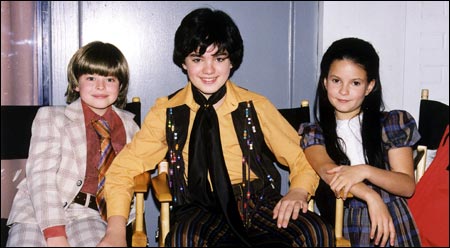 |
[The Guy Maddin story about ABC filming the Osmonds docudrama in Winnipeg is still online -- excerpt below. I think it's a longer version of this story included in From The Atelier Tovar but I could be wrong.]
The Village Voice: Features: Death in Winnipeg by Guy Maddin

Thomas Dekker as Donny (center), with Taylor Abrahamse (Jimmy) and Taylin Wilson (Marie)
photo: Guy Maddin
The fine young artificial brothers, looking warm and cozy beneath period-perfect wigs, are power-chording unplugged guitars and lip-synching to "Crazy Horses," one of the Osmonds' zestiest sorties into Mormon rock. These early-'70s proto-mullets are so natural I'm no longer self-conscious about my own new toupee, which I'm debuting on this occasion. Clad in buttery-soft, fringed white kid leather with matching macramé belts and white platform boots, the five counterfeit siblings retrace to perfection the famously wild and white choreography unleashed on a semiotics-ignorant public almost 30 years ago. These osmonoid performers are really caught up in the song's feral rhythms, rudely beating on brazen vessels, bellowing like stags, and harmonizing like horny barbers: "What a show, there they go, smokin' up the sky-y-y-y-y-y—yeah!!! Crazy horses, all got riders, and they're you and I-I-I-I-I-I-I-I—I!!!" When the number is over, I forget myself and—this is inexcusable for a supposed filmmaker—applaud wildly, actually ruining the take, because the cameras are still running, and the sparse audience in the scene is supposed to be apathetic. Sheepishly, I promise to stopper my fervor. Fortunately, the next take is the keeper.
Posted by Brian Stefans at January 5, 2004 03:49 PM | TrackBackThis variable is then used in various lines of code, holding values given it by variable assignments along the way. In the course of its life, a variable can hold any number of variables and be used in any number of different ways. This flexibility is built on the precept we just learned: a variable is really just a block of bits, and those bits can hold whatever data the program needs to remember. They can hold enough data to remember an integer from as low as -2,147,483,647 up to 2,147,483,647 (one less than plus or minus 2^31). They can remember one character of writing. They can keep a decimal number with a huge amount of precision and a giant range. They can hold a time accurate to the second in a range of centuries. A few bits is not to be scoffed at.
Posted by: Nathaniel at January 19, 2004 05:14 AMEach Stack Frame represents a function. The bottom frame is always the main function, and the frames above it are the other functions that main calls. At any given time, the stack can show you the path your code has taken to get to where it is. The top frame represents the function the code is currently executing, and the frame below it is the function that called the current function, and the frame below that represents the function that called the function that called the current function, and so on all the way down to main, which is the starting point of any C program.
Posted by: Augustus at January 19, 2004 05:14 AMEarlier I mentioned that variables can live in two different places. We're going to examine these two places one at a time, and we're going to start on the more familiar ground, which is called the Stack. Understanding the stack helps us understand the way programs run, and also helps us understand scope a little better.
Posted by: Adam at January 19, 2004 05:15 AMWhen compared to the Stack, the Heap is a simple thing to understand. All the memory that's left over is "in the Heap" (excepting some special cases and some reserve). There is little structure, but in return for this freedom of movement you must create and destroy any boundaries you need. And it is always possible that the heap might simply not have enough space for you.
Posted by: Machutus at January 19, 2004 05:15 AMSeth Roby graduated in May of 2003 with a double major in English and Computer Science, the Macintosh part of a three-person Macintosh, Linux, and Windows graduating triumvirate.
Posted by: Gartheride at January 19, 2004 05:15 AM